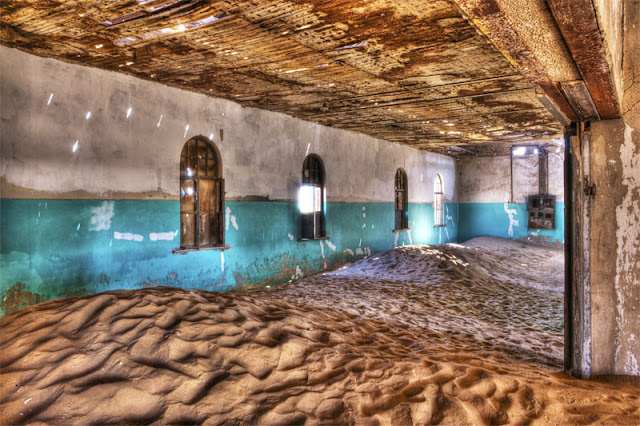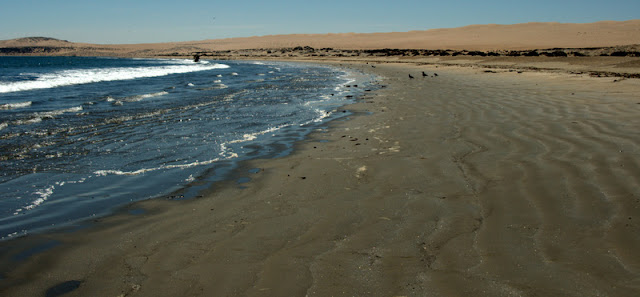For desert dwellers like us, this is a recipe for depression.
While this climate aberration has provided some breathtaking cloud formations,
and its own particular beauty,
we are not cut out for a protracted rainy season like this. When you find yourself staring repeatedly at the horizon trying to will it to provide just a single day of sun relief,
it is time for a break.
All of Namibia has received far higher than normal rain levels this year and we began to think there was no place we could go that it wouldn’t rain. But we had made reservations in Aus for the long holiday weekend so we thought at worst, we would simply watch it rain in new surroundings. Maybe we would get lucky and there would be sun because staying in Windhoek for the weekend, we were guaranteed it was going to look like this all weekend.
So, on the Friday morning of the Independence Day weekend, we headed out, driving south to Keetmanshoop and then due west to Aus.
As we drove out of the mountains that ring Windhoek, there was already more sun. Just past Rehoboth, the sun was brighter still. We couldn’t resist stopping for this now familiar photo op.
We were joined there by numbers of armoured ground crickets maneuvering back and forth across the highway playing chicken with cars, and scurrying back into the tall grasses on the opposite roadside.

As we got closer to Aus, the scenery became more verdant with expanses of lush green grass on offer to some of the roadside grazers.
The last 33 km or so before Aus, the hills in late afternoon were magnificent with white tipped grasses flashing brilliant light in the breeze and hillsides looking as though they had just been fitted out with new, tight green covers.
We arrived at the Gondwana Collection’s Klein Aus Vista Desert Horse Inn just before dark,
and took in a beautiful sunset
before dinner at the lodge.
It had been a long journey so we made an early evening of it, hoping that in the morning, we would see the famous wild horses of the Namib on our way to Luderitz.
The next morning dawned brilliantly sunny and the horses didn’t disappoint. We found them just a little west of the lodge happily grazing grass the excessive rains had made possible.
As we continued west toward Luderitz, the lush green pastures morphed into the more typical arid desert near the coast.
There was blinding sun all the way – our favorite sky status! We began to feel like ourselves again.
Once into Luderitz, we followed the road through town to Agate Beach. The beach gets its captivating name from the pebble-sized, multicolored polished stones on the shore – far larger than regular sand and much prettier.
The color of the water is not a trick of photography. It is precisely that beautiful deep blue.
 |
| Fog bank forming just off the shore headed inland |
We were the only ones there that time of day
 |
| Our car at deserted Agate Beach |
so we took our time watching the fog moving inland from the sea over the hot sands of the Namib.
 |
| View of Agate Beach, Luderitz, Namibia, with fog from the Atlantic moving inland to the desert. |
We left the beach and headed into town for lunch on the patio at the marina.
Luderitz is the wind capital of Namibia. Wind usually howls in this little port town, so much so that there is real interest in building a wind farm nearby or just offshore. But on this day it was dead calm which made for pretty, placid views of the harbor while we ate.
On our way out of town, we stopped for a few photos of the old Lutheran church
and the old buildings.
It was very quiet this public holiday weekend. Things were as calm as the sea this afternoon.
We headed back across the desert toward Klein Aus Vista.
There were more clouds than in the morning but still lots and lots of bright sun.
The horses were still grazing but had moved to the other side of the highway and were coming into the waterhole for late afternoon drinks.
We stopped at the structure near the waterhole to watch them a bit longer.
We still had some beautiful late afternoon light so we went east beyond Aus to the turn off to the C13 gravel road and took it for a while until we came to the vista we had wanted to see once more.

This is the road we had taken to Sossusvlei on our January camping safari.
It was much greener this time. The light was just right to catch and hold sunlight on the tips of the waving grasses. 

The next day we traveled back toward the coast for our second visit to Kolmanskop, about 6 kilometers inland from Luderitz. Kolmanskop is now a ghost town but once was a bustling diamond mining company town. Diamonds were discovered here in 1908 and the town was built to accommodate the explosive growth of this new and compelling industry. There really wasn’t much ‘mining’ involved as a famous picture shows a long line of black men who worked for the mines crawling across the sand on their bellies harvesting diamonds from the surface. They literally just had to scratch the surface to locate the stones.
I took a few photos
 |
| creature prints next to sneaker prints |
 |
| overtaken by the Namib |
| I wonder if a bride ever walked down these stairs to her wedding? |
 |
| desert view |
 |
| hospital hallway |
but the professor who is much more patient than I,
took the time to do it right and his photos are the real beauties from this visit.
 |
| sunroom in the hospital |
 |
| ice factory |
 |
| bakery |
 |
| view from the mine manager's front door |
By the time we were winding up our photo taking, we were the only ones left in the entire ghost town. What a unique experience being in this town by ourselves imagining in the total silence what it might have been like to live here in its heyday.
We arrived to dinner a little late to hear this church choir from Aus who had come to entertain before dinner. It was likely a beautiful recital. I wished we could have heard more.
As we started back to Windhoek the next day, we drove through Aus itself to have a quick look at the town.
The old Bahnhof Hotel has been there since the early 1900’s.
I had to take a photo of this sign. If my mother were still alive, this is the kind of place she could not resist.
What could be better than a coffee AND cake bar? Take my word for it, that is exactly how she would have read this sign! No other pairing of two words in the English language could possibly have had such compelling allure for her.
We had had a solid two days of brilliant sun. In our naiveté, we thought that perhaps things had changed in Windhoek and the sun would also be there to welcome us back. Wrong assumption. It got cloudier and cloudier on the way back,
rained on us a bit as we got closer to Windhoek
then just after we arrived home, poured again.
The evening looked much like this after the rain.
In the morning though, the sunrise was beautiful.
But the day deteriorated to the stormy gray of overcast as the afternoon came on. The rainy season wasn’t over yet.
-------------------------------------------------------------------
Postscript: The rains continued daily through the rest of March, all of April, and are beginning to taper finally in mid-May.


































































Beautiful photos, Lynn!
ReplyDeleteAny idea what the WHITE "KR" sign is for? Outside Luderitz towards Aus
ReplyDeleteCool and I have a nifty give: House Renovation Canada house restoration companies
ReplyDelete